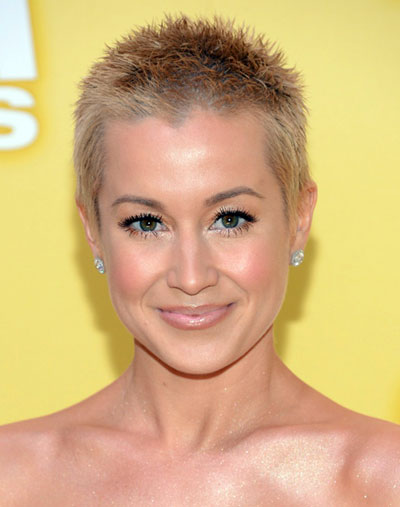New Short Hairstyles Biography
A hairstyle, hairdo, or haircut refers to the styling of hair, usually on the human scalp. The fashioning of hair can be considered an aspect of personal grooming,fashion, and cosmetics, although practical, cultural, and popular considerations also influence some hairstyles
Male styles[edit]
During the 15th and 16th centuries, European men wore their hair cropped no longer than shoulder-length, with very fashionable men wearing bangs or fringes. In Italy it was common for men to dye their hair.[13] In the early 17th century male hairstyles grew longer, with waves or curls being considered desirable.
The male wig was supposedly pioneered by King Louis XIII of France (1601–1643) in 1624 when he had prematurely begun to bald.[14] This fashion was largely promoted by his son and successor Louis XIV of France (1638–1715) that contributed to its spread in European and European-influenced countries. The beard had been in a long decline and now disappeared among the upper classes.
Perukes or periwigs for men were introduced into the English-speaking world with other French styles when Charles II wasrestored to the throne in 1660, following a lengthy exile in France. These wigs were shoulder-length or longer, imitating the long hair that had become fashionable among men since the 1620s. Their use soon became popular in the English court. The London diarist Samuel Pepys recorded the day in 1665 that a barber had shaved his head and that he tried on his new periwig for the first time, but in a year of plague he was uneasy about wearing it:
"3rd September 1665: Up, and put on my coloured silk suit, very fine, and my new periwig, bought a good while since, but darst not wear it because the plague was in Westminster when I bought it. And it is a wonder what will be the fashion after the plague is done as to periwigs, for nobody will dare to buy any haire for fear of the infection? That it had been cut off the heads of people dead of the plague."
Late 17th-century wigs were very long and wavy (see George I below), but became shorter in the mid-18th century, by which time they were normally white (George II). A very common style had a single stiff curl running round the head at the end of the hair. By the late 18th-century the natural hair was often powdered to achieve the impression of a short wig, tied into a small tail or "queue" behind (George III)
Short hair for fashionable men was a product of the Neoclassical movement. Classically inspired male hair styles included the Bedford Crop, arguably the precursor of most plain modern male styles, which was invented by the radical politicianFrancis Russell, 5th Duke of Bedford as a protest against a tax on hair powder; he encouraged his frends to adopt it by betting them they would not. Another influential style (or group of styles) was named by the French after the Roman EmperorTitus, from his busts, with hair short and layered but somewhat piled up on the crown, often with restrained quiffs or locks hanging down; variants are familiar from the hair of both Napoleon and George IV of England. The style was supposed to have been introduced by the actor François-Joseph Talma, who upstaged his wigged co-actors when appearing in productions of works such as Voltaire's Brutus. In 1799 a Parisian fashion magazine reported that even bald men were adopting Titus wigs,[15] and the style was also worn by women, the Journal de Paris reporting in 1802 that "more than half of elegant women were wearing their hair or wig à la Titus."[16]
In the early 19th century the male beard, and also moustaches and sideburns, made a strong reappearance, associated with the Romantic movement, and all remained very common until the 1890s, after which younger men ceased to wear them, withWorld War I, when the majority of men in many countries saw military service, finally despatching the full beard except for older men retaining the styles of their youth, and those affecting a bohemian look. The short military-style moustache remained popular.
"3rd September 1665: Up, and put on my coloured silk suit, very fine, and my new periwig, bought a good while since, but darst not wear it because the plague was in Westminster when I bought it. And it is a wonder what will be the fashion after the plague is done as to periwigs, for nobody will dare to buy any haire for fear of the infection? That it had been cut off the heads of people dead of the plague."










No comments:
Post a Comment